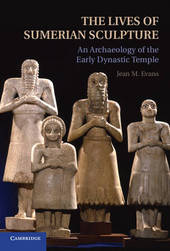
|
The Lives of Sumerian Sculpture: An Archaeology of the Early Dynastic Temple
Hardback
Main Details
| Title |
The Lives of Sumerian Sculpture: An Archaeology of the Early Dynastic Temple
|
| Authors and Contributors |
By (author) Jean M. Evans
|
| Physical Properties |
| Format:Hardback | | Pages:287 | | Dimensions(mm): Height 260,Width 182 |
|
| Category/Genre | Prehistoric archaeology |
|---|
| ISBN/Barcode |
9781107017399
|
| Classifications | Dewey:935.501 |
|---|
| Audience | | Professional & Vocational | |
|---|
| Illustrations |
1 Maps; 58 Halftones, unspecified; 13 Line drawings, unspecified
|
|
Publishing Details |
| Publisher |
Cambridge University Press
|
| Imprint |
Cambridge University Press
|
| Publication Date |
8 October 2012 |
| Publication Country |
United Kingdom
|
Description
This book examines the sculptures created during the Early Dynastic period (2900-2350 BC) of Sumer, a region corresponding to present-day southern Iraq. Featured almost exclusively in temple complexes, some 550 Early Dynastic stone statues of human figures carved in an abstract style have survived. Chronicling the intellectual history of ancient Near Eastern art history and archaeology at the intersection of sculpture and aesthetics, this book argues that the early modern reception of Sumer still influences ideas about these sculptures. Engaging also with the archaeology of the Early Dynastic temple, the book ultimately considers what a stone statue of a human figure has signified, both in modern times and in antiquity.
Author Biography
Jean M. Evans is a Research Associate at the Oriental Institute of the University of Chicago. She has been the recipient of fellowships from the J. Paul Getty Foundation, the American Academic Research Institute of Iraq and the Warburg Institute of the University of London. She was the co-organizer of the international exhibition Beyond Babylon: Art, Trade, and Diplomacy in the Second Millennium B.C. and co-editor of its corresponding publication.
Reviews'Evans' study of Sumerian statues in the Early Dynastic Period gives new arguments and ideas on a long interpretation of material, with a very interesting new perspective that is based on the importance of the archaeological contexts where statues have been recovered and, possibly, lived.' Davide Nadali, Bibliotheca Orientalis
|